A New Fractional-Order Based Intelligent Maximum Power Point Tracking Control Algorithm for Photovoltaic Power Systems
Abstract
This paper proposes a new type of variable fractional-order incremental conductance algorithm (VFOINC), combined with extenics variable step size (EVSS) control into the maximum power point tracking (MPPT) design for photovoltaic power systems. At the beginning of maximum power tracking, the fractional-order number α is selected as 1; the good transient tracking characteristic of traditional incremental conductance method is used. When the maximum power point is approached, the fractional-order number α is selected as variable fractional order; the curve profile of α in fractional order is used to approximate, so that the system has good tracking effect in transient and steady states. The experimental and simulation results show that, compared with traditional incremental conductance method (INC) and fractional-order incremental conductance method (FOINC), this method has better MPPT effect.
1. Introduction
The green energy, including solar energy, wind energy, tide, and geothermal heat, has attracted considerable attention in recent years. Among those, solar energy is one of the cleanest energy sources as the solar radiant energy is converted into electric energy directly [1–5]. The present photovoltaic power systems have low conversion efficiency and high cost, and the power benefit varies with the climatic conditions and ambient temperature. There are some difficulties to be overcome. Due to nonlinearity of the power and voltage of photovoltaic power systems, how to use the MPPT to maximize the output efficiency of photovoltaic power systems in any climatic conditions becomes an important issue.
In actual physical system, many phenomena reflect fractional-order behavior, such as heat transfer and electromagnetic wave in solid [6]. The solar cell is a sort of semiconductor material (single crystalline silicon); the characteristic when the power generated by photocurrent crosses P-N junction (energy gap) reflects the nonlinear characteristic of photovoltage and photocurrent. The interaction between the diffusion current and drift current of semiconductor and the ambient temperature can be described by fractional order [7].
Many MPPT technologies have been implemented in photovoltaic power systems in previous literatures, such as voltage feedback method, power feedback method, INC [8–10], and perturbation and observation (P&O) [11–16]. This paper proposes combining VFOINC with EVSS [17] for tracking the maximum power point. In terms of the selection of derivative order number α, at the beginning of maximum power tracking, α is selected as 1; the good transient tracking characteristic of INC is used. When the maximum power point is approached, α is selected as variable fractional order; the curve profile of α in fractional order is used to approximate, so that the system has good tracking effect in transient and steady states. The experimental and simulation results show that the VFOINC + EVSS method proposed in this paper uses DC/DC boost converter to adjust the duty cycle; compared with the INC and FOINC, the VFOINC + EVSS proposed in this paper can shorten the time for MPPT, so that the efficiency of photovoltaic power systems is increased.
2. Brief Introduction to Photovoltaic Power Systems
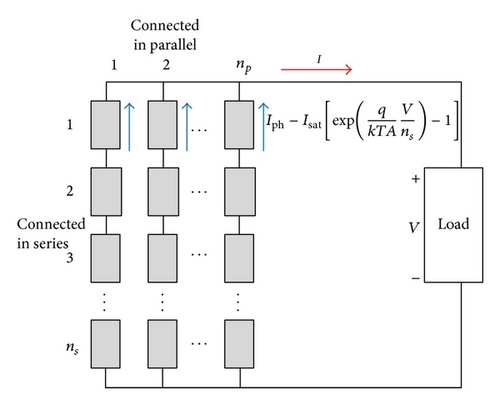
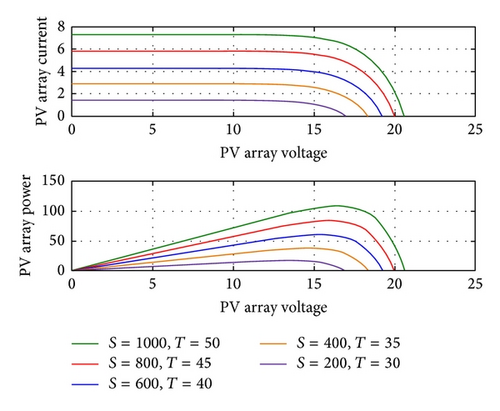
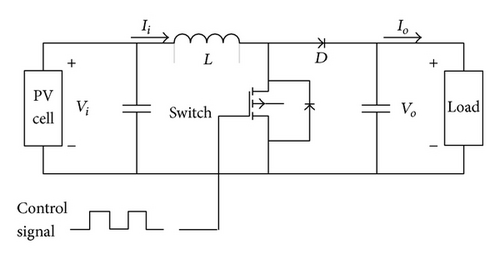
Among multiple solar power system MPPT methods, the P&O is most extensively used [11–16] due to simple structure and few parameters required, and the parameters of characteristic curve of photovoltaic power system are not required. However, this method uses periodic perturbation, so there will be oscillation at the maximum power point, causing some unnecessary power loss. The INC is proposed in order to overcome this defect.
The photovoltaic power system architecture proposed in this paper is shown in Figure 4. The photovoltaic panel connects the output voltage and current to the DC-DC boost converter directly, and the MPPT is used to control signal and adjust the duty cycle of switching pulse width modulation (PWM). Finally, the DC-DC boost converter is connected to the load to measure the system output power.
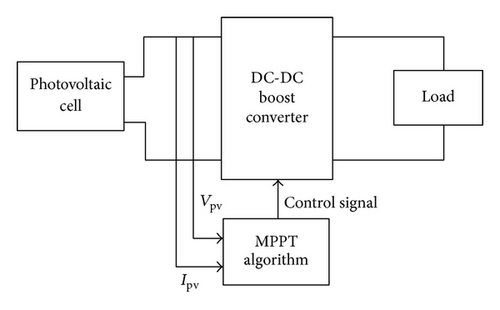
3. Design of Algorithm and Control Method
This paper uses MATLAB R2010a Simulink to build the simulated photovoltaic power system architecture and to design the control method. Figure 5 shows the photovoltaic power system simulation built by this paper. The module FOINC can be replaced by different MPPTs for duty cycle control of different switching pulse adjustment control methods.
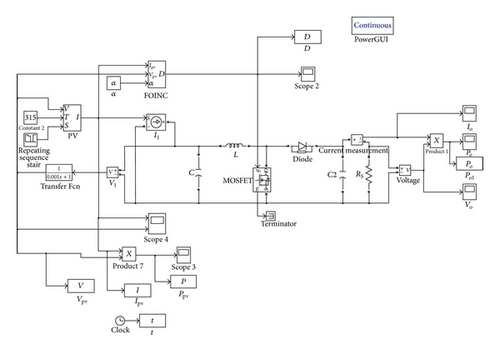
3.1. Fractional-Order Differentiator
3.2. Variable Fractional-Order Incremental Conductance Method
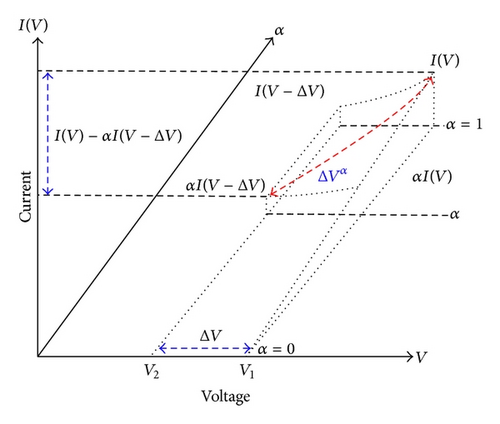
This paper uses voltage V and current I and power P as calculated variance in captured signal, voltage, and current, ΔV = V − Vo, ΔI = I − Io, and the slope is the slope (ΔP/ΔV) of power-voltage curve of solar cell; the variation of partial voltage and current of fractional-order differentiator approximates as dαI = I − αI0 and . In terms of selection of derivative order number α, at the beginning of MPPT, α is selected as 1; the good transient tracking characteristic of traditional INC is used. When the MPP is approached, α is selected as variable fractional-order form, and the curve profile of α in fractional order is used to approximate, so that the system has good tracking effect in transient and steady states.
3.3. Extenics Variable Step Size (EVSS)
The offset ΔV during MPPT of traditional INC determines the tracking speed and the perturbation accuracy when the MPP is reached. In comparison to traditional MPPT algorithm, the variable step size control has gradually increased or decreased offset ΔV variable of step size, so as to improve the tracking speed and stability. For detailed variable step size control, please refer to [20].
As the variable step size control has variable step size nearby MPP, there will be voltage perturbation problem nearby MPP. Therefore, this paper proposes adding extenics theory in the variable step size control [22, 23] to deduce the EVSS. The voltage, power, and slope are captured as reference frame, so that the minimum step size can be used for perturbation nearby the MPP, increasing the efficiency of photovoltaic power system. The control flow of VFOINC + EVSS proposed in this paper is shown in Figure 7.
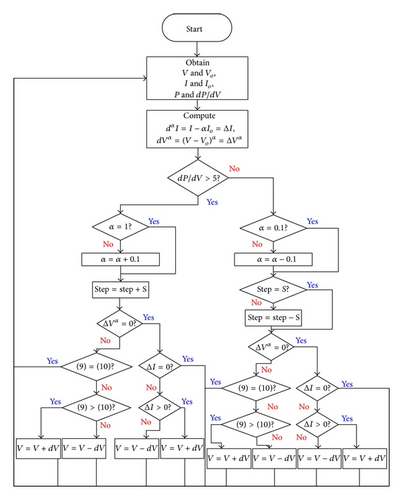
4. Simulation Analysis Results and Comparison
This paper uses MATLAB R2010a Simulink to build the model and controller of photovoltaic power system. This simulation is the comparison of different states of irradiance and temperature and step size. Figure 8 shows the curve test of photovoltaic power system at specific temperature and irradiance, including voltage-power (P-V) curve, current-voltage (I-V) curve, duty ratio (cycle) (D), and tracking number curves.
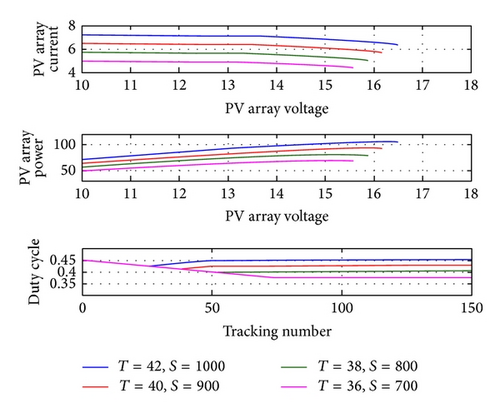
The first simulated condition is irradiance 1000 kW/m2 and temperature 25°C; the other condition is irradiance decreasing from 1000 kW/m2 to 900 kW/m2 and then decreasing to 200 kW/m2 and increasing to 1000 kW/m2, and the INC, FOINC, and VFOINC + EVSS are compared.
According to the simulation result in Figure 9, as the step size of INC depends on the user, the speed and accuracy are limited to some extent. However, in the same step size, the transient tracking speed of INC is better than FOINC. In terms of the combination of VFOINC and EVSS, Figure 10 shows the combination of good transient tracking efficiency of traditional INC and steady-state stability of VFOINC and EVSS; it is observed that the VFOINC + EVSS proposed in this paper has better MPPT simulation curve in transient and steady states.
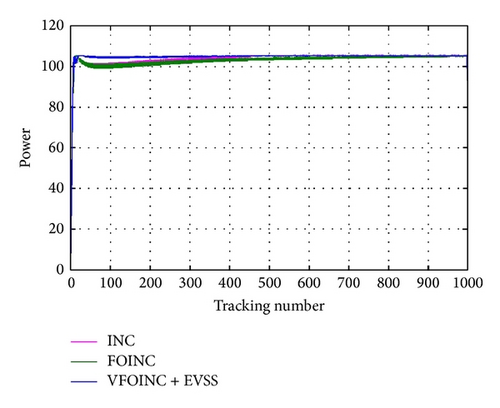
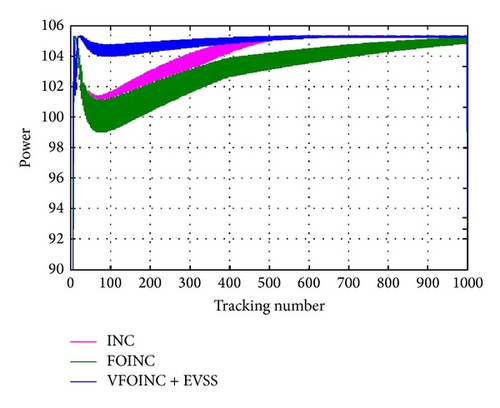
The second simulated condition is the irradiance decreasing from 1000 kW/m2 to 900 kW/m2 and then decreasing to 200 kW/m2 and increasing to 1000 kW/m2, as shown in Figure 11. The INC, FOINC, and VFOINC + EVSS are compared. The variance in α is shown in Figure 12.
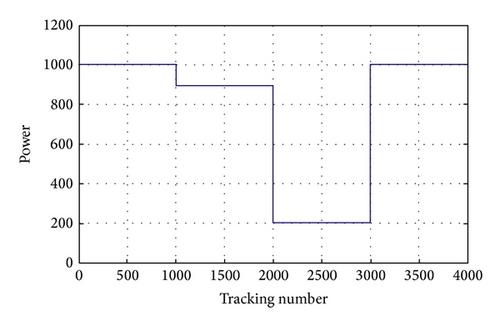

Figure 12 shows the variance in α. It is observed that, at the start of simulation, as the system is just started up, letting α = 1 for tracking MPP, the form of INC is used for tracking; α is reduced to 0.1 gradually when MPP is approached, so that the system uses INC in transient state and uses VFOINC in steady state. In addition, in terms of α variation when the tracking number is 1000, 2000, and 3000, the MPP shifts as the irradiance changes; the system increases α value again to increase the tracking speed and reduces it to 0.1 again when the MPP is approached, so that the transient and steady-state response curves have better effect.
Figure 13 shows the simulation result, and Figure 14 shows that the step size of INC still depends on the user; the speed and accuracy are limited to some extent, so that the MPPT always costs a long time in the case of variable irradiance, causing unnecessary power loss. The VFOINC + EVSS proposed in this paper can improve the excessive tracking number of traditional INC algorithm in the case of variable irradiance, so that the system has better curve.
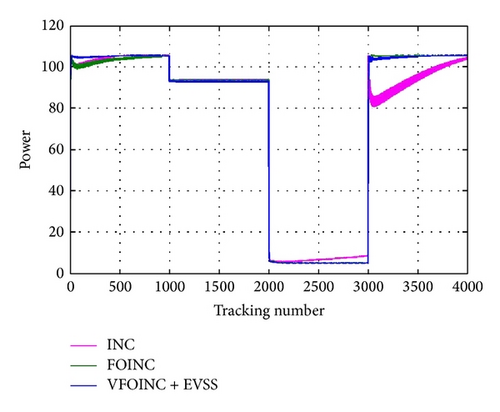
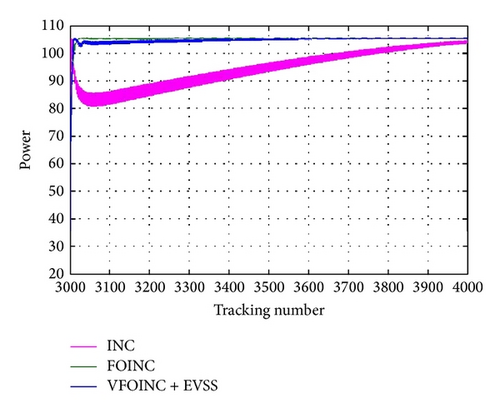
5. Experimental Results
In order to show the efficiency of this scheme in real solar cell system, the performance of the proposed controller was evaluated experimentally and was compared with INC method and FOINC method. The specification of the experimental solar panel is shown in Table 1. Figure 15 shows the experimental results obtained for the output power given a uniform irradiance of 1000 W/m2. From the results, it can be seen that VFOINC + EVSS has better tracking rates than traditional INC and in terms of the steady-state response it is also good and has the same effect. In order to show that this scheme is robust to the irradiance, the results of irradiances changed from 1000 kW/m2 to 400 kW/m2 and then increased to 1000 kW/m2 as shown in Figure 16. Our results are also consistent with the results of the simulations. It can prove the feasibility of the proposed method.
| Pmax | VMPP | IMPP | VOC | ISC |
|---|---|---|---|---|
| 17 W | 18 V | 0.94 A | 21.24 V | 1.04 A |
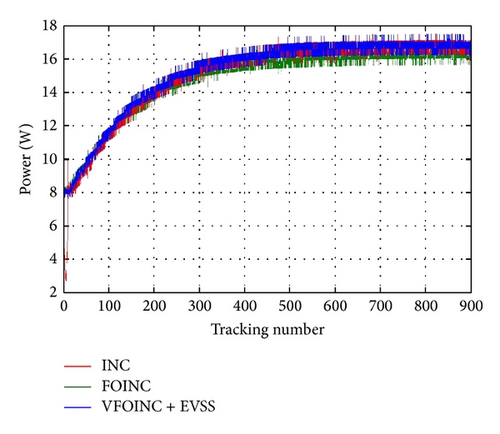
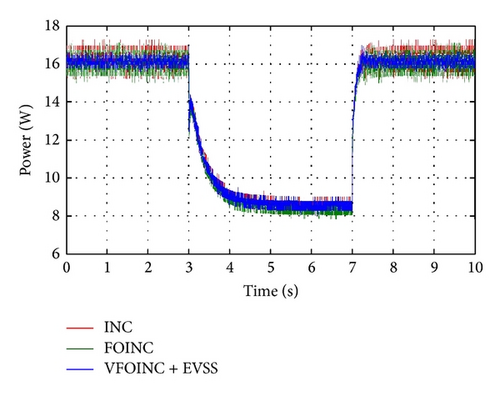
6. Conclusion
This paper uses VFOINC + EVSS for photovoltaic power system MPPT control, to improve the MPPT speed and steady-state perturbation of INC. In terms of selection of derivative order number α, at the start of MPPT, α is selected as 1; the good tracking characteristic of traditional INC in transient state is used. When the MPP is approximated, α is selected as variable fractional-order form; the curve profile of α in fractional order is used to approximate, so that the system has good tracking effect in transient and steady states. According to the simulation result of the algorithm, the transient and steady-state responses of the control method proposed in this study to photovoltaic MPPT system are better than those of INC and FOINC, meaning this method for MPPT can reduce unnecessary power loss of the system, so as to increase the generating efficiency of system.
Conflict of Interests
The authors declare that there is no conflict of interests regarding the publication of this paper.




